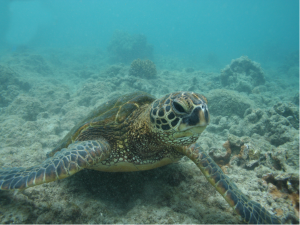
Since 1987, our students have been working with Mr. George Balazs and other NOAA / NMFS sea turtle biologists to capture, measure, tag and study the threatened Hawaiian green sea turtle (Chelonia mydas). This work originally took place at Kiholo Bay, a prime habitat for juvenile and sub-adult green turtles on the leeward coast of Hawai’i Island. While Kiholo is still an important focus of our research, we now have study sites along the entire coast from Honaunau in the south to Kawaihae in the North. Below is a map of the leeward coast of the Big Island showing our main study sites. ON the left is a short description of the characteristics of each site.
STUDY SITES ON THE BIG ISLAND
Kawaihae- juvenile and subadult feeding and resting habitat
Puako- fisheries management area- juvenile and subadult feeding and resting habitat
Mauna Lani- offshore resting area and inshore feeding – juvenile and subadult
Waikoloa- semi-enclosed lagoon near Dolphin Quest ponds.. resting area for juvenile and sub-adults. One Hawksbill tagged in lagoon
Kiholo- extensive feeding area and resting area. Lagoon area very important resting area for juvenile and sub-adult green turtles. Four hawksbill turtles tagged in this lagoon
Hualalai/Kukio- extensive feeding and resting area. Some Basking on the sand beaches and lava rocks
Kaloko- Honokohau National Historical Site – extensive forage grounds near shore for sub-adults and juvenile green turtles. Offshore resting habitat and cleaning stations
Kahalu’u Beach State Park- semi-enclosed bay with feeding shallows for green turtles
Pu’u Honua O’ honaunau national historical site- small forage area near the park for juvenile and sub-adult green turtles

